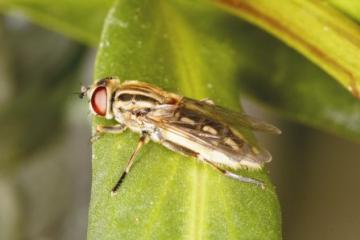Species Account for Lejops vittatus
Lejops vittatus (Meigen, 1822)
Diptera: Syrphidae: Syrphidae

Reproduction for study and non-profit use permitted, all other rights reserved.
Taxonomic group: hoverflies (Diptera: Syrphidae) - Available county data
View time series maps for Lejops vittatus
member log-on for taxon report
Status: NS;NT
Essex RDB: Listed
Threat: Essex Vulnerable
Images
upload a new image
Essex Red Data List comment
Known from very few sites in the county. It may have gone from a borrow dyke at Barling, owing to pollution. It has not been recorded from Benfleet Marsh since 1947. A nationally rare hoverfly with most records from south-eastem England. The classic habit is amongst stands of Sea Club-rush Scirpus maritimus along ditches on grazing marshes (subject of a BAP). Essex may hold a substantial proportion of the national population.
Species text
Lejops vittatus is a scarce coastal species, with most records from the Thames Marshes. The larvae are aquatic, eggs apparently being laid on stems and leaves of emergent plants. After hatching larvae remain at the water surface amongst floating plants until the last instar when they move into submerged organic ooze (Ball & Morris, 2000). There is a close association with Sea Club-rush Bolboschoenus (Scirpus) maritimus growing along ditches or in adjacent marsh, indicative of brackish conditions, where females can be found feeding on pollen (Stubbs & Falk, 2002). References
Habitats
Recorded management for locations with Lejops vittatus
Recorded substrate and hydrology for locations with Lejops vittatus
Why not join the Club, register and add a new species page
Interpretation of distribution maps



















